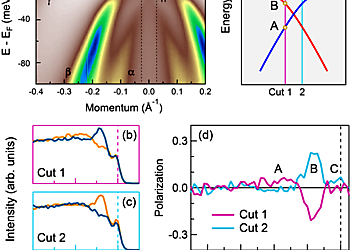Multiple Topological States in Iron-Based Superconductors
Result of the Month
Topological materials and unconventional iron-based superconductors are both important areas of study but, to date, relatively little overlap has been identified between these two fields. However, the combination of topological bands and superconductivity promises the manifestation of exotic superconducting states, including Majorana fermions, the central component of topological quantum computation. Here, using laser-based, spin-resolved and angle-resolved photoemission spectroscopy and density functional theory calculations, we have identified both topological insulator and Dirac semimetal states near the Fermi energy in different iron-based superconducting compounds. Carrier doping can tune these topologically non-trivial bands to the Fermi energy, potentially allowing access to several different superconducting topological states in the same material. These results reveal the generic coexistence of superconductivity and multiple topological states in iron-based superconductors, indicating that this broad class of materials is a promising platform for high-temperature topological superconductivity.
Authors: Peng Zhang1*, Zhijun Wang2, Xianxin Wu3, Koichiro Yaji1, Yukiaki Ishida1, Yoshimitsu Kohama1, Guangyang Dai4, Yue Sun1,5, Cedric Bareille1, Kenta Kuroda1, Takeshi Kondo1, Kozo Okazaki 1, Koichi Kindo1, Xiancheng Wang4, Changqing Jin4, Jiangping Hu4,6, Ronny Thomale3, Kazuki Sumida7, Shilong Wu8, Koji Miyamoto8, Taichi Okuda8, Hong Ding4,6, G. D. Gu9, Tsuyoshi Tamegai5, Takuto Kawakami10, Masatoshi Sato10 and Shik Shin1*
Institutes:
1) Institute for Solid State Physics, University of Tokyo, Kashiwa, Japan.
2) Department of Physics, Princeton University, Princeton, NJ, USA.
3) Institut für Theoretische Physik und Astrophysik, Julius-Maximilians-Universität Würzburg, Würzburg, Germany.
4) Beijing National Laboratory for Condensed Matter Physics and Institute of Physics, Chinese Academy of Sciences, Beijing, China.
5) Department of Applied Physics, University of Tokyo, Tokyo, Japan.
6) CAS Center for Excellence in Topological Quantum Computation, University of Chinese Academy of Sciences, Beijing, China.
7) Graduate School of Science, Hiroshima University, Higashi-Hiroshima, Japan.
8) Hiroshima Synchrotron Radiation Center, Hiroshima University, Higashi-Hiroshima, Japan.
9) Condensed Matter Physics and Materials Science Department, Brookhaven National Laboratory, Upton, NY, USA.
10) Yukawa Institute for Theoretical Physics, Kyoto University, Kyoto, Japan
References: Prof. Shik Shin et al. Multiple topological states in iron-based superconductors. Nature Physics Vol. 15, January 2019, 41–47. https://doi.org/10.1038/s41567-018-0280-z
Name and email of corresponding authors:
Peng Zhang zhangpeng@issp.u-tokyo.ac.jp
Shik Shin shin@issp.u-tokyo.ac.jp

